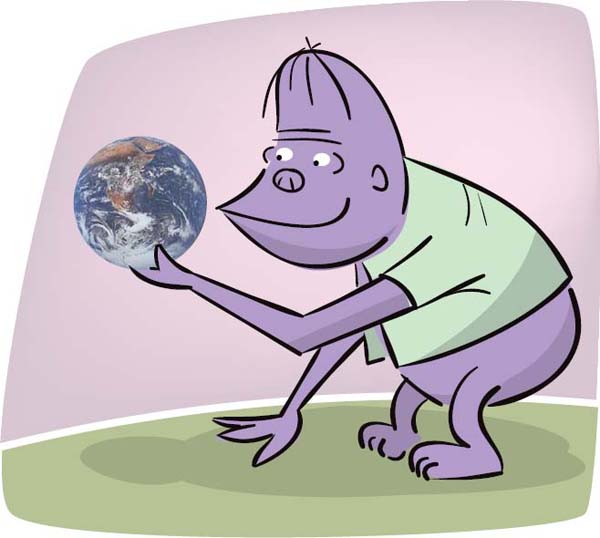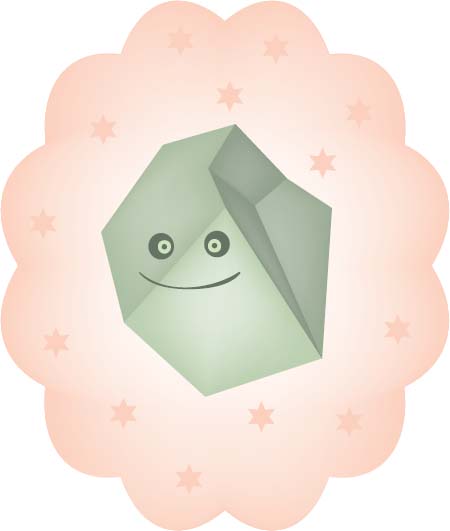

My name is Tambuzi. I’m a genetically modified gorilla geologist with an IQ of 200. Professor Zoober rescued me as an orphaned gorilla in the mountains of Africa several years ago, and using intelligence-boosting technology developed on his planet, he made me one of the smartest beings on Earth. I chose to study geology and to make it my profession. The word “geology” comes from Greek words meaning “earth” and “discuss.” Since I am a geologist, I am going to discuss the Earth with you.
The planet we live on was created about 4.7 billion years ago. Around that time, the solar system was a big swirling cloud of dust and gas. The middle part was very hot, and as the dust began to settle, our sun formed there. Smaller clouds of dust circling the sun formed into planets. One of these was the Earth.
In those early days, lots of meteorites were whizzing around, and every time one of them hit the Earth, it raised its temperature. Meanwhile, a lot of the metal in the Earth was radioactive, which made the planet even hotter. After a billion years or so, the surface of the Earth cooled down enough to form a crust. But even today, the center of the Earth is a ball of molten metal.
Every once in a while the hot interior of the planet shoots through openings in the Earth’s crust. These volcanic eruptions spew molten rock, hot ashes, and gases into the air, often causing a great deal of damage and loss of life. In 1985, the Nevada del Ruiz volcano in Colombia erupted, and the tide of blistering hot lava wiped out an entire city. In 1815, the eruption of Mount Tambora in Indonesia released as much energy as 6 million atom bombs.
But volcanoes aren’t just destroyers; they’re also creators. The Hawaiian Islands, for example, were formed over a period of millions of years as an undersea volcano sent up countless tons of lava from the floor of the ocean many miles below the surface. Hawaii still has active volcanoes, and visitors can peer into the craters and get a glimpse of the lava burbling below.
Even though I am a gorilla, I am also a “rock hound.” This is the name for a person who likes to collect rocks. I have thousands of rocks in my collection, which I store in oatmeal boxes under my bed. There are three kinds of rocks, and I have many examples of each: (1) igneous rocks, (2) sedimentary rocks, and (3) metamorphic rocks. Igneous rocks are formed from magma, which is what lava is called before it shoots out of a volcano. Some igneous rocks are hard and smooth, like obsidian, which looks like black glass. Another kind of igneous rock, called pumice, is so soft and lightweight that it can float in water. Sedimentary rocks are made from accumulated dirt and old plant and animal matter. After millions of years, this stuff hardens into rocks. Fossils are examples of sedimentary rocks. Metamorphic rocks are rocks that have changed in appearance and structure after they’ve been squeezed under the surface of the earth or heated by magma. A metamorphic rock called quartzite is made of sandstone that has been recrystallized by extreme pressure.
Quartzite is a very common kind of crystallized rock, but a diamond is more popular, not just because it is rare and pretty, but because it is the hardest substance found in nature. People use diamonds to saw and drill into rocks and other hard material. The only thing that can cut a diamond is another diamond. Diamonds are made out of carbon, the same stuff that’s in your pencil’s “lead.” But if they’re both made from carbon, why is a diamond so hard while a pencil lead is so soft? The answer is that the carbon atoms in diamonds are lined up in a special repeating pattern, called a crystal structure. I know how to make many kinds of crystals, but I can’t make a diamond. You need to squeeze carbon very hard to create a diamond, and even though I am a powerful gorilla, my fist just isn’t strong enough! I have made crystals out of salt, sugar, and many other materials, and in my experiments, I’ll teach you how to make them, too.
